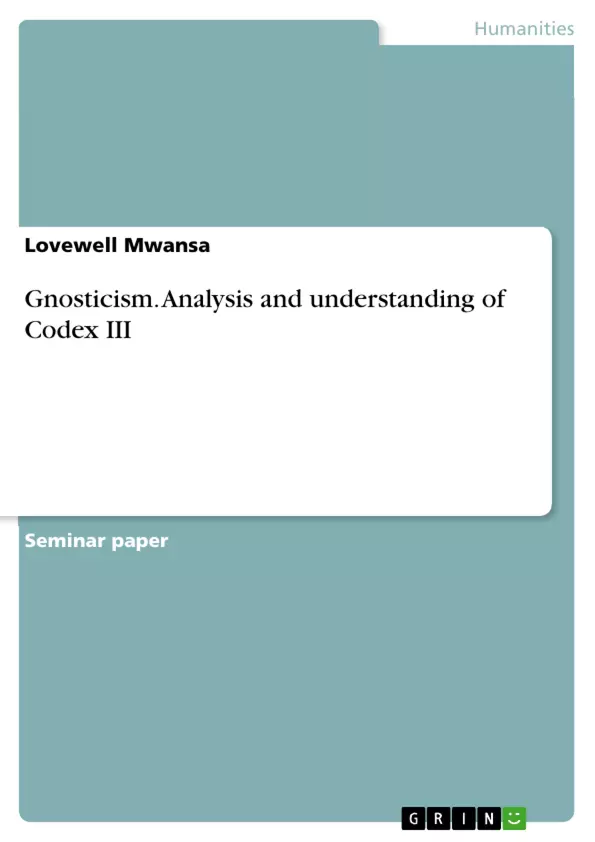Stephen Robinson states that the term 'Gnostic' comes from the Greek word for knowledge (gnosis). Fundamental to Gnosticism was the belief that the principle of knowledge is the principle of salvation, and that it is impossible for a man to be saved in ignorance. Personal revelation was crucial. The knowledge necessary for salvation consisted, according to many Gnostic writings, of higher teachings and ordinances taught by Jesus and his disciples and transmitted in oral traditions which were most often too secret and sacred to be written down or to be discussed with any who were not worthy of them.
On those occasions when they were written down, they appear to have been closely held and committed to writing only in an effort to preserve them for future generations. Although orthodox Christianity has emphatically denied that any such esoteric teachings ever existed, Gnosticism insisted not only that they were an important part of earliest Christianity, but also that they were the most important part.
Even if Gnosticism has been known to scholars in a less complete form with the aid of the writings of the church fathers and by an occasional manuscript, usually it has been treated as a form of devious Christianity having only secondary significance. The discovery of the Nag Hammadi library has reemphasized the fact that Gnosticism was the church and not merely the heretic fringe of the universal church.
According to Michael Kaler, Gnosticism was a religious movement which denigrated this cosmos and awaited a saviour figure who would rescue the gnostic believers from it, and the Valentinianism is regarded to be one of the two main branches of Gnosticism, along with Sethianism, so that insofar as the Apocalypse of Paul is Valentinian, it is also gnostic by default.
Inhaltsverzeichnis (Table of Contents)
- Analysis and understanding of Codex III
- Gnosticism and the Nag Hammadi Library
- The Apocalypse of James
- The Second Revelation of James
- The Apocalypse of Adam
Zielsetzung und Themenschwerpunkte (Objectives and Key Themes)
This research paper aims to provide an analysis and understanding of Codex III, a collection of ancient Gnostic texts discovered in the Nag Hammadi Library. It explores the nature of Gnosticism, examining its core beliefs, historical context, and relationship to early Christianity. The paper further delves into the significance of specific texts within Codex III, such as the Apocalypses of James and Adam, and explores their unique perspectives on salvation, revelation, and the nature of the cosmos.
- The nature and origins of Gnosticism
- The relationship between Gnosticism and early Christianity
- The role of revelation and knowledge in Gnostic beliefs
- The interpretation of the Old Testament in Gnostic texts
- The impact of Codex III on our understanding of early Christianity
Zusammenfassung der Kapitel (Chapter Summaries)
- Analysis and understanding of Codex III: This chapter introduces the concept of Gnosticism and its historical significance. It discusses the origins of the term "Gnostic" and the core beliefs of the Gnostic movement. The chapter also highlights the importance of the Nag Hammadi Library in shedding light on Gnosticism and its relationship to early Christianity.
- The Apocalypse of James: This chapter delves into the First and Second Revelations of James, analyzing their content and theological perspectives. It explores the significance of the revelations in the context of Gnostic thought, highlighting their unique interpretations of salvation, suffering, and the role of the risen Christ.
- The Apocalypse of Adam: This chapter examines the Apocalypse of Adam, a Gnostic interpretation of the book of Genesis. It discusses the nature of the text, its relationship to other Gnostic writings, and its potential Jewish sources. The chapter also addresses the question of whether the Apocalypse of Adam is Pre-Christian or not, highlighting different scholarly viewpoints on the topic.
Schlüsselwörter (Keywords)
The key terms and focus topics of this research paper include: Gnosticism, Codex III, Nag Hammadi Library, Apocalypses of James and Adam, Revelation, Salvation, Knowledge, Early Christianity, Jewish Gnosticism, Pre-Christian Gnosticism, Interpretation of the Old Testament, Theosophy, Syzygies, Anthropomorphism.
- Arbeit zitieren
- Dr. Lovewell Mwansa (Autor:in), 2022, Gnosticism. Analysis and understanding of Codex III, München, GRIN Verlag, https://www.hausarbeiten.de/document/1383176


